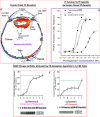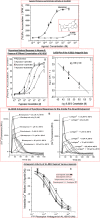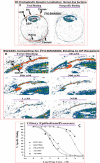Discovery to Launch of Anti-allergy (Emadine; Patanol/Pataday/Pazeo) and Anti-glaucoma (Travatan; Simbrinza) Ocular Drugs, and Generation of Novel Pharmacological Tools Such as AL-8810
- PMID: 33344909
- PMCID: PMC7737327
- DOI: 10.1021/acsptsci.0c00137
Discovery to Launch of Anti-allergy (Emadine; Patanol/Pataday/Pazeo) and Anti-glaucoma (Travatan; Simbrinza) Ocular Drugs, and Generation of Novel Pharmacological Tools Such as AL-8810
Abstract
The eye and eyesight are exquistly designed and are precious, and yet we often take them for granted. Good vision is critical for our long-term survival and for humanity's enduring progress. Unfortunately, since ocular diseases do not culminate in life-and-death scenarios, awareness of the plight of millions of people suffering from such eye ailments is not publicized as other diseases. However, losing eyesight or falling victim to visual impairment is a frightening outlook for most people. Glaucoma, a collection of chronic optic neuropathies, of which the most prevalent form, primary open-angle glaucoma (POAG), is the second leading cause of irreversible blindness. POAG currently afflicts >70 million people worldwide and is an insidious, progressive, silent thief of sight that is asymptomatic. On the other hand, allergic conjunctivitis (AC), and the associated rhinitis ("hay-fever"), frequently victimizes a huge number of people worldwide, especially during seasonal changes. While not life-threatening, sufferers of AC soon learn the value of drugs to treat their signs and symptoms of AC as they desire rapid relief to overcome the ocular itching/pain, redness, and tearing AC causes. Herein, I will describe the collective efforts of many researchers whose industrious, diligent, and dedicated team work resulted in the discovery, biochemical/pharmacological characterization, development and eventual launch of drugs to treat AC (e.g., olopatadine [Patanol/Pataday/Pazeo] and emedastine [Emedine]), and for treating ocular hypertension and POAG (e.g., travoprost [Travatan ] and Simbrinza). This represents a personal perspective.
© 2020 American Chemical Society.
Conflict of interest statement
The author declares no competing financial interest.
Figures
















Similar articles
-
The added benefit of local Patanol therapy when combined with systemic Claritin for the inhibition of ocular itching in the conjunctival antigen challenge model.Acta Ophthalmol Scand Suppl. 1999;(228):53-6. doi: 10.1111/j.1600-0420.1999.tb01175.x. Acta Ophthalmol Scand Suppl. 1999. PMID: 10337434 Clinical Trial.
-
A randomized, double-blind, parallel-group comparison of olopatadine 0.1% ophthalmic solution versus placebo for controlling the signs and symptoms of seasonal allergic conjunctivitis and rhinoconjunctivitis.Clin Ther. 2003 Mar;25(3):931-47. doi: 10.1016/s0149-2918(03)80115-7. Clin Ther. 2003. PMID: 12852709 Clinical Trial.
-
Olopatadine ophthalmic solution adjunctive to loratadine compared with loratadine alone in patients with active seasonal allergic conjunctivitis symptoms.Ann Allergy Asthma Immunol. 2001 Jun;86(6):641-8. doi: 10.1016/S1081-1206(10)62292-2. Ann Allergy Asthma Immunol. 2001. PMID: 11428736 Clinical Trial.
-
A review of olopatadine for the treatment of ocular allergy.Expert Opin Pharmacother. 2004 Sep;5(9):1979-94. doi: 10.1517/14656566.5.9.1979. Expert Opin Pharmacother. 2004. PMID: 15330735 Review.
-
Efficacy and tolerability of newer antihistamines in the treatment of allergic conjunctivitis.Drugs. 2005;65(2):215-28. doi: 10.2165/00003495-200565020-00004. Drugs. 2005. PMID: 15631542 Review.
Cited by
-
Neuroaxonal and cellular damage/protection by prostanoid receptor ligands, fatty acid derivatives and associated enzyme inhibitors.Neural Regen Res. 2023 Jan;18(1):5-17. doi: 10.4103/1673-5374.343887. Neural Regen Res. 2023. PMID: 35799502 Free PMC article. Review.
-
Therapeutic Drugs and Devices for Tackling Ocular Hypertension and Glaucoma, and Need for Neuroprotection and Cytoprotective Therapies.Front Pharmacol. 2021 Sep 17;12:729249. doi: 10.3389/fphar.2021.729249. eCollection 2021. Front Pharmacol. 2021. PMID: 34603044 Free PMC article. Review.
-
Recently Approved Drugs for Lowering and Controlling Intraocular Pressure to Reduce Vision Loss in Ocular Hypertensive and Glaucoma Patients.Pharmaceuticals (Basel). 2023 May 26;16(6):791. doi: 10.3390/ph16060791. Pharmaceuticals (Basel). 2023. PMID: 37375739 Free PMC article. Review.
References
LinkOut - more resources
Full Text Sources
